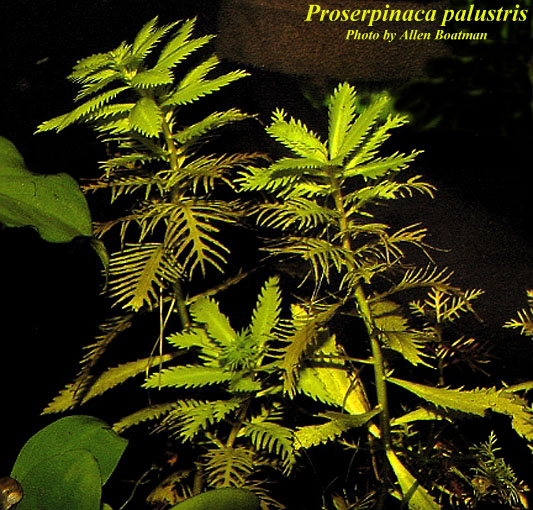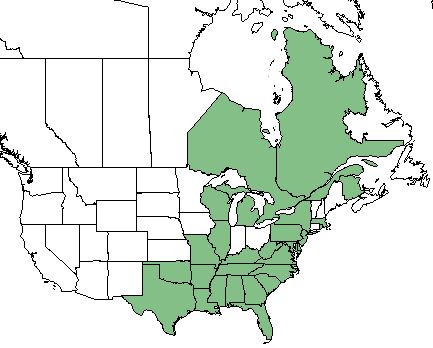Difference between revisions of "Proserpinaca palustris"
(→Ecology) |
HaleighJoM (talk | contribs) (→Ecology) |
||
| Line 42: | Line 42: | ||
===Fire ecology=== <!--Fire tolerance, fire dependence, adaptive fire responses--> | ===Fire ecology=== <!--Fire tolerance, fire dependence, adaptive fire responses--> | ||
Populations of ''Proserpinaca palustris'' have been known to persist through repeated annual burning.<ref>Platt, W.J., R. Carter, G. Nelson, W. Baker, S. Hermann, J. Kane, L. Anderson, M. Smith, K. Robertson. 2021. Unpublished species list of Wade Tract old-growth longleaf pine savanna, Thomasville, Georgia.</ref> | Populations of ''Proserpinaca palustris'' have been known to persist through repeated annual burning.<ref>Platt, W.J., R. Carter, G. Nelson, W. Baker, S. Hermann, J. Kane, L. Anderson, M. Smith, K. Robertson. 2021. Unpublished species list of Wade Tract old-growth longleaf pine savanna, Thomasville, Georgia.</ref> | ||
| − | <!--===Pollination and | + | <!--===Pollination===--> |
| − | <!--==Diseases and parasites==--> | + | <!--===Herbivory and toxicology===<!--Common herbivores, granivory, insect hosting, poisonous chemicals, allelopathy, etc--> |
| + | <!--===Diseases and parasites===--> | ||
==Conservation, cultivation, and restoration== | ==Conservation, cultivation, and restoration== | ||
Latest revision as of 14:23, 15 July 2022
Common names: marsh mermaidweed[1]
| Proserpinaca palustris | |
|---|---|

| |
| Photo by Allen Boatman hosted at Atlas of Florida Plants | |
| Scientific classification | |
| Kingdom: | Plantae |
| Division: | Magnoliophyta - Flowering plants |
| Class: | Magnoliopsida - Dicots |
| Order: | Haloragales |
| Family: | Haloragaceae |
| Genus: | Proserpinaca |
| Species: | P. palustris |
| Binomial name | |
| Proserpinaca palustris L. | |

| |
| Natural range of Proserpinaca palustris from USDA NRCS Plants Database. | |
Contents
Taxonomic Notes
Synonym: none
Variety: Proserpinaca palustris var. amblyogona (Fernald), Proserpinaca palustris var. crebra (Fernald & Griscom)
Description
P. palustris is a perennial forb/herb of the Haloragaceae family that is native to North America.[1]
Distribution
P. palustris can be found throughout the eastern United States, as far west as Texas, as well as Ontario and Quebec, Canada. [1]
Ecology
Habitat
Habitats are limited to swamps and other wetlands or swamp forests.[2] Specimens have been collected from shallow water of a roadside ditch, dry center of a pond, and tidal swamp with a canopy of tupelo.[3]
Phenology
P. palustris has been observed flowering in July.[4]
Fire ecology
Populations of Proserpinaca palustris have been known to persist through repeated annual burning.[5]
Conservation, cultivation, and restoration
Cultural use
Photo Gallery
References and notes
- ↑ 1.0 1.1 1.2 USDA Plant Database
- ↑ Weakley, A. S. (2015). Flora of the Southern and Mid-Atlantic States. Chapel Hill, NC, University of North Carolina Herbarium.
- ↑ URL: http://herbarium.bio.fsu.edu. Last accessed: June 2018. Collectors: Loran C. Anderson, Rodie White, Jean W. WOoten, Robert K. Godfrey, R. Komarek, J.M. Kane, William Platt, Keith A. Bradley, M. Darst, L. Webster, L. Lewis. States and counties: Florida (Jefferson, Hillsborough, Leon, Gulf, Levy) Georgia (THomas, Grady) South Carolina (Aiken)
- ↑ Nelson, G. PanFlora: Plant data for the eastern United States with emphasis on the Southeastern Coastal Plains, Florida, and the Florida Panhandle. www.gilnelson.com/PanFlora/ Accessed: 24 MAY 2018
- ↑ Platt, W.J., R. Carter, G. Nelson, W. Baker, S. Hermann, J. Kane, L. Anderson, M. Smith, K. Robertson. 2021. Unpublished species list of Wade Tract old-growth longleaf pine savanna, Thomasville, Georgia.